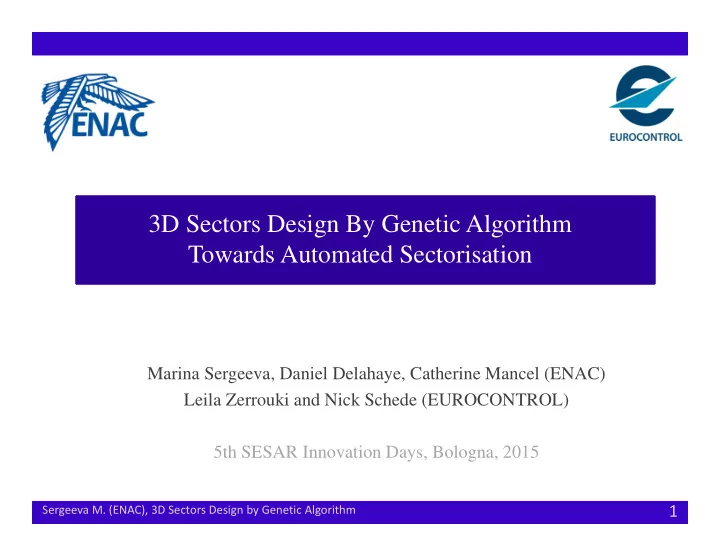

3D Sectors Design By Genetic Algorithm Towards Automated Sectorisation Marina Sergeeva, Daniel Delahaye, Catherine Mancel (ENAC) Leila Zerrouki and Nick Schede (EUROCONTROL) 5th SESAR Innovation Days, Bologna, 2015 1 Sergeeva M. (ENAC), 3D Sectors Design by Genetic Algorithm
Introduction An elementary sector is defined as a volume of the • airspace, within which the air traffic controller can perform his controlling function. Area Control Centers (ACC) consists of several • elementary sectors. When traffic demand capacity issue is identified or • change of traffic patterns occurs a new sector design of the ACC should be proposed. 2 Sergeeva M. (ENAC), 3D Sectors Design by Genetic Algorithm
Motivation Implementation of the Free Routing concept. • Continuous air traffic growth congested • airspace. Limited flexibility of current sector design. • Complexity of the sector design task. • 3 Sergeeva M. (ENAC), 3D Sectors Design by Genetic Algorithm
Sector design problem The airspace sector design problem consists in • searching a partition of a given airspace domain D into a set of N operationally workable sectors [s1, ... ,sn]. The quality of the sector design is evaluated • according several geometrical and operational constraints. 4 Sergeeva M. (ENAC), 3D Sectors Design by Genetic Algorithm
Problem Description workload imbalance between elementary sectors The workload is computed as: (crossing time for all aircraft) * (time to monitor one aircraft) + (total number of conflicts) * (time to solve one conflict) ATC coordination workload 5 Sergeeva M. (ENAC), 3D Sectors Design by Genetic Algorithm
Problem Description the number of flight re-entry events the number of entry conflict points close to the sector borders the number of short crossings shapes of sectors such as ”balconies” connectivity 6 Sergeeva M. (ENAC), 3D Sectors Design by Genetic Algorithm
Pre-processing step New cells built using k-means 3D airspace discretized using grid cells (<5NM) algorithm projected on the 2D plane 7 Sergeeva M. (ENAC), 3D Sectors Design by Genetic Algorithm
Preparing airspace blocks for sector building process Airspace blocks in 3D 8 Sergeeva M. (ENAC), 3D Sectors Design by Genetic Algorithm
Preparing airspace blocks for sector building process ACC Airspace 3D blocks 9 Sergeeva M. (ENAC), 3D Sectors Design by Genetic Algorithm
Sector building process Process of building sectors in 2D 3D extension 10 Sergeeva M. (ENAC), 3D Sectors Design by Genetic Algorithm
Solution representation • The solution of the sector design process can be represented in the following form : • With number of building blocks > 100 and the number of layers > 2 the number of possible combinations is big stochastic optimization is required. 11 Sergeeva M. (ENAC), 3D Sectors Design by Genetic Algorithm
Evolutionary Algorithm 12 Sergeeva M. (ENAC), 3D Sectors Design by Genetic Algorithm
Objective Function � � � � � � � �� � �� � � � � - workload imbalance between all elementary sectors � � - total flow cuts � � - total number of re-entries � �� - total number of short-crossings � �� - total number of entering conflicts � � - total number of “balconies” � � - � � - proportion coefficients 13 Sergeeva M. (ENAC), 3D Sectors Design by Genetic Algorithm
ASTAAC Interface 14 Sergeeva M. (ENAC), 3D Sectors Design by Genetic Algorithm
Results obtained with ASTAAC for Maastricht/Amsterdam Airspace (EDYYDUTA) • for 12/07/2014 11h-13h (peak hours) • proportion coefficients of the objective function: • Scenario 1: � = 0.3, � = � = 0.25, � � =0.4, � Scenario 2: � = 0.6, � = � = 0.25, � � =0.5, � 15 Sergeeva M. (ENAC), 3D Sectors Design by Genetic Algorithm
Results: Scenario 1 Upper layer Lower layer Traffic data: for 12/07/2014 11h-13h for Maastricht/Amsterdam Airspace (EDYYDUTA). 16 Sergeeva M. (ENAC), 3D Sectors Design by Genetic Algorithm
Results: Scenario 1 Scenario 1 Original/Reference Scenario sector workload short ‐ cross e ‐ conflicts re ‐ entr sector workload short ‐ cross e ‐ conflicts re ‐ entr 0 4273 4 0 0 0 3008 0 0 0 1 4058 3 1 0 1 993 4 0 0 2 3642 3 0 0 2 5663 4 0 0 3 3695 1 0 0 3 1928 2 1 1 4 3923 3 0 0 4 8493 1 0 3 5 4426 4 0 0 5 3140 6 0 2 Traffic data: for 12/07/2014 11h-13h 17 Sergeeva M. (ENAC), 3D Sectors Design by Genetic Algorithm
Results: Scenario 1 Traffic data: for 12/07/2014 11h-13h 18 Sergeeva M. (ENAC), 3D Sectors Design by Genetic Algorithm
Results: Scenario 2 Scenario 2 Original/Reference Scenario sector workload short ‐ cross e ‐ conflicts re ‐ entr sector workload short ‐ cross e ‐ conflicts re ‐ entr 0 2817 3 0 0 0 3008 0 0 0 1 6116 2 0 1 1 993 4 0 0 2 3183 3 1 0 2 5663 4 0 0 3 3327 1 0 0 3 1928 2 1 1 4 5073 1 0 0 4 8493 1 0 3 5 3501 2 0 0 5 3140 6 0 2 Traffic data: for 12/07/2014 11h-13h for Maastricht/Amsterdam Airspace (EDYYDUTA). 19 Sergeeva M. (ENAC), 3D Sectors Design by Genetic Algorithm
Results: Scenario 2 Traffic data: for 12/07/2014 11h-13h 20 Sergeeva M. (ENAC), 3D Sectors Design by Genetic Algorithm
Conclusions Proposed sector design algorithm is able to provide very • satisfying design regrading workload balancing and sectors shape. Proposed algorithm is flexible and can be calibrated according to • different preferences. Next step includes adding new complexity metric for the • workload evaluation. Algorithm can be adapted for Dynamic Sector Configurations. • 21 Sergeeva M. (ENAC), 3D Sectors Design by Genetic Algorithm
Thank you for your attention. 22 Sergeeva M. (ENAC), 3D Sectors Design by Genetic Algorithm
Recommend
More recommend